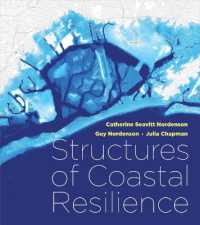- ホーム
- > 洋書
- > 英文書
- > Science / Mathematics
Full Description
This book provides a hands-on introduction to the construction and application of models to studies of vertebrate distribution, abundance, and habitat. The book is aimed at field biologists, conservation planners, and advanced undergraduate and postgraduate students who are involved with planning and analyzing conservation studies, and applying the results to conservation decisions. The book also acts as a bridge to more advanced and mathematically challenging coverage in the wider literature.
Part I provides a basic background in population and community modeling. It introduces statistical models, and familiarizes the reader with important concepts in the design of monitoring and research programs. These programs provide the essential data that guide conservation decision making. Part II covers the principal methods used to estimate abundance, occupancy, demographic parameters, and community parameters, including occupancy sampling, sample counts, distance sampling, and capture-mark-recapture (for both closed and open populations). Emphasis is placed on practical aspects of designing and implementing field studies, and the proper analysis of data. Part III introduces structured decision making and adaptive management, in which predictive models are used to inform conservation decision makers on appropriate decisions in the face of uncertainty—with the goal of reducing uncertainty through monitoring and research. A detailed case study is used to illustrate each of these themes.
Numerous worked examples and accompanying electronic material (on a website - http://www.blackwellpublishing.com/conroy - and accompanying CD) provide the details of model construction and application, and data analysis.
Contents
Preface vii
Acknowledgements ix
Companion website and CD-ROM x
1 Introduction: the role of science in conservation 1
Part I Basic concepts in scientific investigations for conservation 7
2 Using models in conservation biology 9
3 Models of population dynamics 15
4 Applying population models to conservation 32
5 Basics of study design and analysis 47
Part II Conservation studies and monitoring programs 71
6 General principles of estimation 73
7 Occupancy (presence-absence) analysis 81
8 Sample counts for abundance estimation 101
9 Distance sampling for estimating density and abundance 115
10 Capture-mark-recapture studies for estimating abundance and density 135
11 Estimation of survival from radiotelemetry, nesting success studies, and age distributions 160
12 Mark-recapture for estimating survival, recruitment, abundance, and movement rates 189
13 Analysis of habitat 219
14 Estimation of species richness and other community parameters 230
Part III Integrating modeling and monitoring for conservation 251
15 Elements of conservation decision making 253
16 Accounting for uncertainty in conservation decisions 265
17 Learning and adaptive management 274
18 Case study: decision modeling and adaptive management for declining grassland birds in the southeastern USA 289
19 Summary and recommendations 303
Literature cited 307
Glossary 314
Appendix A: Statistical and modeling programs available on the worldwide web 324
Appendix B: Other internet resources 326
Appendix C: Modeling and statistical notation 328
Appendix D: Key to abundance and parameter estimation 331
Index 337







